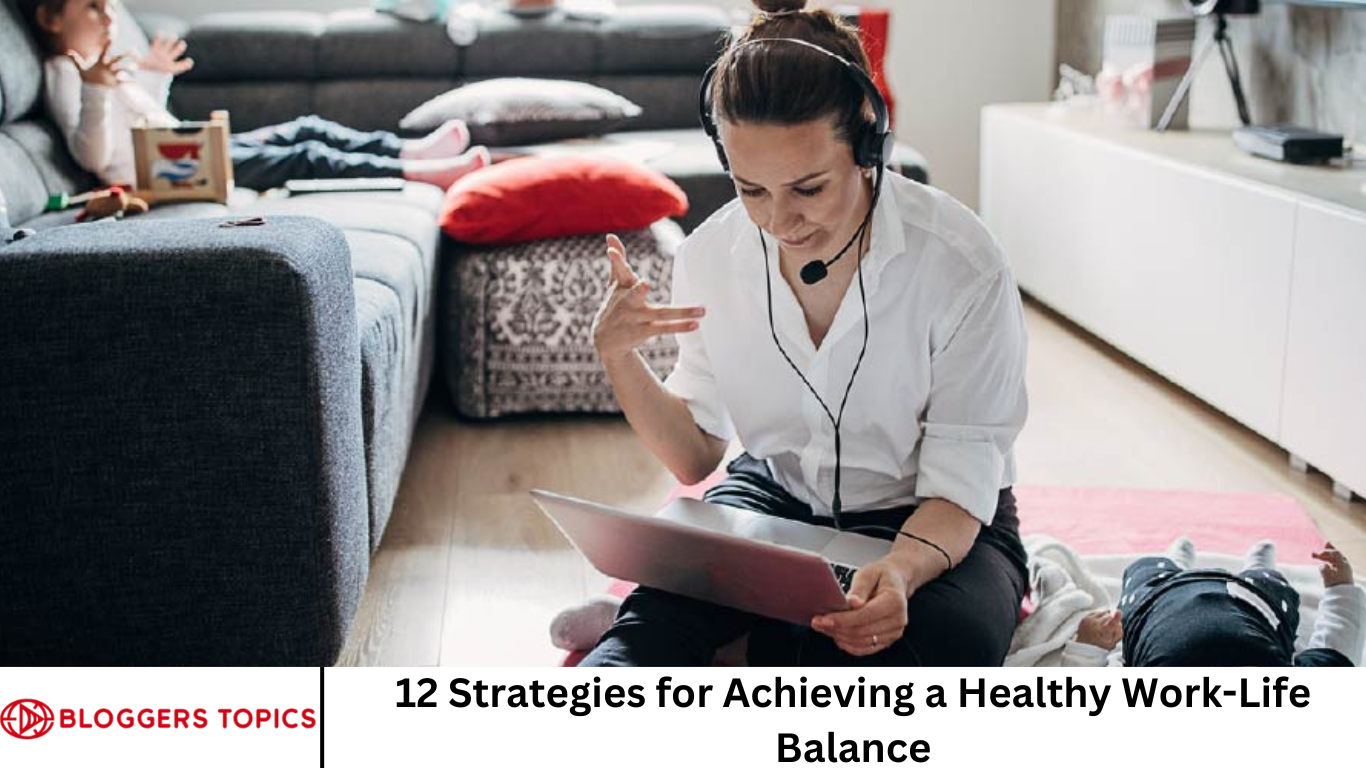Fast-paced world, achieving a healthy work-life balance has become more challenging than ever before. With the advent of remote work, advancements in technology, and increased demands on employees, maintaining a boundary between work and personal life is more critical than ever.
Finding a balance that works for you can lead to improved productivity, greater happiness, and better mental and physical health. In this article, we will explore 12 strategies for achieving a healthy work-life balance, so you can thrive both professionally and personally.
More Read: Meal Prep Tips for a Busy Week (Including Recipes)
1. Set Clear Boundaries Between Work and Personal Life
One of the most important aspects of maintaining work-life balance is setting clear boundaries. In the age of remote work, it’s all too easy for work to spill over into your personal time. To avoid burnout and stress, it’s crucial to establish designated work hours and spaces.
Actionable Steps:
- Create a designated workspace: Whether it’s a home office or a corner of your living room, having a physical space where you work can help separate your professional and personal lives.
- Set specific work hours: Stick to a routine, ensuring that you start and finish work at consistent times each day. Communicate these boundaries to your employer and colleagues.
- Turn off work notifications: After work hours, disable email and messaging notifications so you’re not constantly checking in.
By maintaining physical and psychological boundaries, you’ll find it easier to switch off from work when it’s time to relax.
2. Prioritize Time Management
Effective time management is crucial to achieving a healthy work-life balance. When you manage your time well, you’re more likely to stay productive during working hours and avoid overworking.
Actionable Steps:
- Use a calendar or planner: Organize your day by prioritizing your tasks. Use digital tools or planners to schedule your work hours, meetings, and personal activities.
- Break tasks into smaller steps: Divide large tasks into smaller, manageable parts to reduce feelings of overwhelm.
- Avoid multitasking: Focus on one task at a time to ensure higher productivity and quality of work.
When you manage your time well, you’ll have more free time to enjoy your personal life without worrying about unfinished tasks.
3. Learn to Say No
Many people struggle to maintain a work-life balance because they have trouble saying no to additional tasks and responsibilities. While it’s important to be a team player, overcommitting yourself can lead to burnout. Learning to say no, when necessary, is an essential skill for protecting your time and energy.
Actionable Steps:
- Assess your workload: Before taking on additional tasks, evaluate your current workload and determine whether you have the bandwidth to take on more.
- Set realistic expectations: When agreeing to tasks, communicate clearly about your availability and deadlines.
- Practice saying no: Politely decline tasks or projects that will interfere with your work-life balance.
Saying no isn’t about being uncooperative; it’s about ensuring that you’re able to give your best to the tasks and responsibilities you already have.
4. Take Regular Breaks
Taking regular breaks throughout the day is crucial for maintaining productivity and avoiding burnout. Without breaks, your mind and body can become fatigued, leading to diminished focus and productivity.
Actionable Steps:
- Follow the 90-minute rule: Work in focused 90-minute intervals, followed by short breaks. This method mimics the body’s natural energy cycles and improves focus.
- Get up and stretch: Physical movement is key to preventing burnout and improving concentration.
- Use break time to do something you enjoy: Whether it’s a walk, meditation, or reading a book, use your break time to engage in an activity that recharges you.
Incorporating breaks into your daily routine can help prevent mental exhaustion and allow you to approach your work with renewed focus.
5. Delegate Tasks
Delegation is a critical component of managing both work and personal life. When you try to do everything yourself, it can quickly lead to feeling overwhelmed. Delegating tasks, whether at work or at home, allows you to focus on your most important responsibilities.
Actionable Steps:
- Delegate tasks at work: If you’re overwhelmed, consider delegating tasks to coworkers who have the necessary skills and availability.
- Delegate household tasks: Share household responsibilities with family members, roommates, or hire help if necessary.
- Use outsourcing tools: Utilize tools and services to outsource tasks that don’t require your immediate attention, such as grocery shopping or administrative work.
By delegating effectively, you free up time for yourself and ensure that tasks are handled by the right people.
6. Embrace Flexibility
Flexibility is one of the greatest advantages of modern work environments, particularly with the rise of remote work and flexible hours. Embracing flexibility can help you create a work-life balance that fits your unique needs and lifestyle.
Actionable Steps:
- Set flexible work hours: If your employer allows it, adjust your work schedule to better fit your personal commitments.
- Work from home when possible: Take advantage of remote work opportunities to avoid commuting and have more control over your environment.
- Adapt your routine to your needs: If you need to adjust your hours to take care of family or personal matters, discuss options with your employer.
Flexibility can allow you to better manage your work and personal life without compromising one for the other.
7. Make Time for Self-Care
Self-care is essential for maintaining a healthy work-life balance. Without taking care of your mental, physical, and emotional well-being, it becomes increasingly difficult to manage work and personal life effectively.
Actionable Steps:
- Exercise regularly: Physical activity is not only good for your body but also for your mind. Aim for at least 30 minutes of exercise most days of the week.
- Prioritize sleep: Aim for 7-9 hours of sleep each night to ensure that your body and mind are well-rested.
- Practice mindfulness or meditation: Stress management techniques, such as mindfulness or meditation, can help you stay grounded and focused.
When you prioritize self-care, you’re better equipped to handle the demands of both work and life.
8. Foster Strong Support Networks
Having a strong support network is essential for managing work-life balance. Surrounding yourself with supportive friends, family, and colleagues can help you navigate challenges and create a healthier balance between work and personal life.
Actionable Steps:
- Communicate with your partner or family: Share your work commitments and personal needs with your partner and family members to create a sense of teamwork.
- Connect with coworkers: Build relationships with colleagues who understand the pressures of balancing work and personal life.
- Seek professional support: Consider working with a mentor, counselor, or life coach to help you navigate challenges and set realistic goals.
A strong support network can help alleviate stress and provide guidance during times of difficulty.
9. Disconnect from Technology
Constant connectivity through smartphones and emails can blur the line between work and personal life. Setting boundaries with technology is key to achieving a healthy work-life balance.
Actionable Steps:
- Set “no screen” times: Designate specific times in the evening or weekend when you disconnect from technology and focus on personal activities.
- Turn off notifications: Disable push notifications on your phone and computer to avoid constant interruptions during your personal time.
- Engage in non-digital hobbies: Pursue activities that don’t involve screens, such as reading, cooking, or outdoor activities.
By disconnecting from technology when it’s time to relax, you can improve your focus and enjoy your personal time without distractions.
10. Learn to Prioritize
Knowing how to prioritize is essential for managing your time effectively and maintaining a healthy work-life balance. Not everything requires your immediate attention, and learning to prioritize your tasks will help you focus on what’s most important.
Actionable Steps:
- Identify urgent vs. important tasks: Focus on completing tasks that are both urgent and important first, then move on to less critical items.
- Use the Eisenhower Matrix: Categorize tasks into four quadrants (urgent/important, important/not urgent, urgent/not important, and neither) to help you prioritize effectively.
- Don’t overcommit: Avoid taking on more than you can handle by focusing on the tasks that align with your goals and values.
Prioritizing allows you to manage your time and energy more efficiently, ensuring that you give your best to both work and personal activities.
11. Set Realistic Goals
Setting realistic goals helps you maintain focus and avoid the feeling of being overwhelmed. Having clear goals for both your work and personal life allows you to track your progress and feel accomplished.
Actionable Steps:
- Set short-term and long-term goals: Break down your objectives into smaller, manageable steps. This will help you stay motivated and on track.
- Be flexible with your goals: Life can be unpredictable, so be open to adjusting your goals as needed to reflect your changing circumstances.
- Celebrate small wins: Acknowledge and celebrate your accomplishments, no matter how small. This reinforces positive behavior and helps you stay motivated.
Setting achievable goals provides clarity and a sense of direction, making it easier to maintain a work-life balance.
12. Reflect and Adjust Regularly
Achieving a work-life balance is an ongoing process that requires regular reflection and adjustments. Your needs, priorities, and responsibilities may change over time, so it’s important to reassess your balance periodically.
Actionable Steps:
- Review your schedule: Take time at the end of each week to evaluate your work-life balance. Are you feeling overwhelmed? Do you need more personal time?
- Adjust your boundaries: If necessary, adjust your work hours or boundaries to reflect changes in your workload or personal life.
- Seek feedback: Talk to family members, friends, or colleagues to get feedback on how well you’re balancing your work and personal life.
Regular reflection helps you stay aligned with your goals and make necessary adjustments to ensure a healthy balance.
Frequently Asked Question
Why is work-life balance important?
Work-life balance is essential because it helps prevent burnout, reduces stress, and improves overall mental and physical well-being. Achieving a healthy balance allows you to be more productive at work and enjoy your personal life, leading to a more fulfilling and sustainable lifestyle.
How can I set boundaries between work and personal life when working from home?
To set boundaries when working from home, create a designated workspace, set specific work hours, and avoid checking emails or work messages after hours. Inform your colleagues and family about your boundaries to help minimize interruptions during personal time.
What can I do if I have trouble saying no to extra work?
If you struggle to say no, start by evaluating your current workload and priorities. Politely explain to colleagues or managers if you don’t have the bandwidth for additional tasks. Practice setting boundaries, and remember that declining extra work helps preserve your time and energy for your existing responsibilities.
How can I improve my time management to achieve better work-life balance?
Improving time management involves organizing your tasks with tools like calendars or planners, setting realistic deadlines, and breaking down large projects into smaller tasks. Avoid multitasking, as it can reduce productivity. Prioritize the most important tasks to help maintain balance throughout your day.
What role does self-care play in maintaining work-life balance?
Self-care is vital for staying healthy, focused, and energized. Regular exercise, healthy sleep habits, mindfulness practices, and taking time for hobbies help reduce stress and ensure that you’re physically and mentally prepared for both work and personal activities.
How do I stay flexible with my work schedule while maintaining productivity?
Embrace flexibility by discussing with your employer the possibility of adjusting your work hours or working remotely when needed. Adapt your routine to fit your personal responsibilities while ensuring you complete your work on time. Balancing flexibility with clear communication ensures you stay productive while managing your personal life.
How often should I reassess my work-life balance?
You should reassess your work-life balance regularly—weekly, monthly, or as your circumstances change. Reflect on whether you’re feeling overwhelmed or disconnected from your personal life and make adjustments as necessary to avoid burnout and maintain overall well-being.
Conclusion
Achieving a healthy work-life balance is not a one-size-fits-all approach. It requires intentionality, self-awareness, and a willingness to make adjustments as your circumstances change. By implementing these 12 strategies—setting boundaries, prioritizing self-care, embracing flexibility, and more—you can create a balanced and fulfilling life. Ultimately, work-life balance is about finding what works best for you and ensuring that both your professional and personal lives are satisfying and sustainable.







